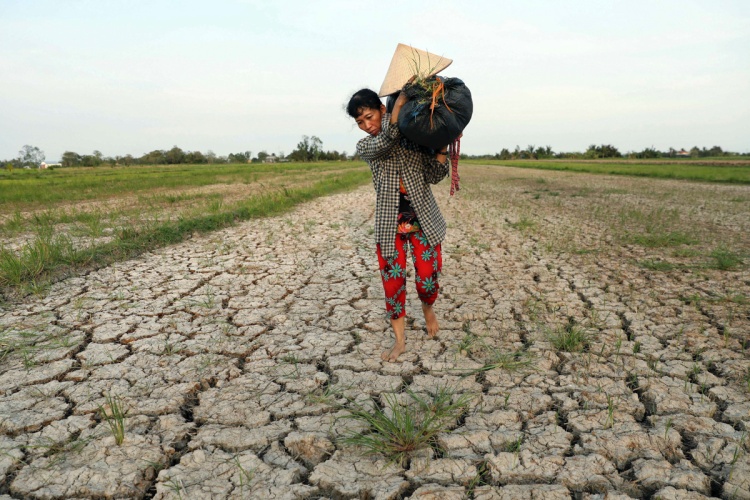Climate change challenges have assumed deadly serious proportions in Vietnam, demanding that the country steps up contributions to meeting global temperature goals.
“The existing extreme weather phenomena in Vietnam will likely become the new normal in the future,” said Associate Professor Ngo Duc Thanh, Co-Director of the Space and Aeronautics Department, University of Science and Technology of Hanoi.
He was speaking at a round table discussion on “Overcoming climate change challenges in Vietnam, 5 years after the Paris Agreement” held Wednesday in Hanoi. The event was organized by the Embassy of France and GreenID, on the occasion of the fifth anniversary of the Paris Agreement being signed on December 12.
The Paris Agreement, trying to strengthen the global response to climate change, reaffirmed the goal of limiting global temperature increase to below 2 degrees Celsius, while pursuing efforts to limit the increase to 1.5 degrees.
Thanh said his assessment was based on his calculations showing that climate change has been really happening in Vietnam.
Between 1961 and 2007, the temperatures rose in most weather stations in Vietnam and rainfall decreased in the north while increasing in the south. The rainfall pattern has been behind increased flooding as well as drought that the country has been suffering in recent years.
The latest data shows that Hanoi’s average daily temperatures in the 1961-2020 period has climbed around 2 degrees Celsius. Thanh said that beside climate change, rapid urbanization was most likely an important factor in this big increase.
“The weather today is much hotter than the time when our grandparents did not have (or need) air-conditioners,” he said.
The Southeast Asia region as a whole is expected to reach the point of a 2 degrees Celsius increase in temperature by 2047, based on a high emissions scenario, according to the 2018 report of the Southeast Asia Regional Climate Downscaling/Coordinated Regional Climate Downscaling Experiment Southeast Asia. Thanh was one of the report’s authors.
“It means that countries have to make a great effort in emissions reduction to achieve the target of keeping the temperature increase at 2 degrees Celsius by the end of the century,” Thanh said.
French ambassador Nicolas Warnery said that internationally, 2020 is expected to be one of the warmest years in history. He said that even though greenhouse gas emissions dropped following the Covid-19 pandemic, it did not reflect a structural change. Based on current trends in greenhouse gas emissions and climate action, a 1.5 degrees temperature rise is expected before 2050, and 4 degrees could be reached before 2100.
Energy emissions going up
Nguy Thi Khanh, Executive Director, Green Innovation and Development Centre (GreenID), noted that among various sources in Vietnam, including agriculture, land use, land-use change, and forestry and industrial processes, the production and consumption of energy accounts for a majority of CO2 emissions.
Correspondingly, energy generated over 171 million tons of CO2 in 2014, 60 percent of the total, the estimation in 2020 is 347 million tons (66 percent), and for 2030 is 678 million tons (73 percent), according to the Intended Nationally Determined Contribution of Vietnam report.
“Energy plays a very important role in emission reduction,” she said.
Khanh said it was important that Vietnam makes major changes in its approach to achieve its emission goals. Vietnam should not build new coal power plants, it should focus on expanding renewable energy sources, build a clear policy roadmap for synchronous renewable energy reserves to guarantee investors’ confidence, and devise an economic transformation strategy. Transparent policies will also help Vietnam to attract green credit internationally, she said.
Vietnam will face numerous challenges with renewable energy plans needing more land (which may lead to conflicts of interest in land use), ensuring energy security as well as people’s livelihoods, and setting up appropriate transmission networks for renewable energy. The country will also need adequately skilled human resources for developing renewable energy sources, she said.
Some positive signals
Khanh said there have been some positive signals in the energy market and indications of policy change in Vietnam.
In the global market, renewable energy has developed to “the point of no return”. Renewable energy projects are booming in many places, coal power plants are on a downtrend, and LNG is on the uptrend. She cited the 2019 report of the International Renewable Energy Agency (IRENA) to show that capacity and investment for renewable energy continued to increase more rapidly than that of fossil fuels and nuclear power; over 50 percent of capacity of additional renewable energy in 2019 had lower costs compared with new coal plants. Solar and wind energy are increasingly more competitive than fossil fuels on a commercial scale, she noted.
Vietnam cannot escape this trend, but the issue is “how quick and how sustainable renewable energy development is in Vietnam,” she said.
Khanh also said she believes Vietnam has the dynamics needed for shifting from traditional energy sources to new ones. The demand for electricity is growing while primary energy sources are running out; there is abundant potential for renewable energy including solar, wind, biomass energy and other, newer sources.
In Ninh Thuan and Binh Thuan provinces in central Vietnam, many solar and wind energy plans are being implemented. Advanced technologies and lower costs are allowing Vietnam to make renewable energy a serious sector, something that looked impossible even five years ago.
On the policy front, Khanh said that in the Politburo’s Resolution No 55 on “Orientations of the Vietnam’s National Energy Development Strategy to 2030 and outlook to 2045,” which was made public in February 2020, it is stated that Vietnam has a policy supporting preferential purchase prices for solar, wind and biomass power. In other words, the country makes clear its priority for developing renewable energy and reducing fossil fuel at appropriate levels.
“This is the first time Vietnam has raised the issue in a high-level document,” Khanh said.
In addition, in the National VIII Power Plan, the proportion of renewable energy is scheduled to increase while the ratio of coal power plants will decrease from 43 percent to 27 percent of total power generation by 2030.
Making a broader view on policy aspect, Pham Van Tan, Deputy Director General, Department of Meteorology, Hydrology and Climate Change, Ministry of Natural Resources and Environment of Vietnam, said Vietnam’s National Assembly passed amendments to the Law on Environment Protection on November 17, that includes a chapter of climate change and implementation responsibility for Paris Agreement.
It said the emission plan is compulsory for everyone from 2021. Vietnam will also set up a domestic carbon market for businesses.
Tan said Vietnam is the first among developing countries to have an implementation plan for the Paris Agreement in 2016, not long after signing the deal. On November 11, Vietnam was one of 20 countries that submitted the updated version of the Intended Nationally Determined Contribution. He said Vietnam announced a legal commitment, meaning that it will have to implement it.
Ambassador Warnery said it is essential that countries act collectively by raising their climate ambition before the 26th UN climate change conference next year with new “nationally determined contributions” objectives based on low-emission development strategies.
So far, only a few countries in the world have done so, and Vietnam is one of them, he said. It has increased its ambition in greenhouse gas emissions reduction from 8 percent to 9 percent by 2030 without international aid, and from 25 to 27 percent with aid.
Within this optimistic context, the market has huge expectations of politicians, Khanh of GreenID said, adding, the “pressure on policymakers is enormous.”
This story published by VNExpress has been shared as part of World News Day 2021, a global campaign to highlight the critical role of fact-based journalism in providing trustworthy news and information in service of humanity. #JournalismMatters.




